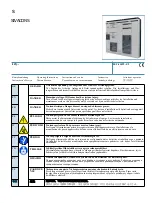
RP Series
March 2011
47
The basic parts of the above message are:
Message Component
Example
Headers
SOURC VOLT FREQ CURR
Header Separator
The colon in SOUR:VOLT
Data
80
60
Data Separator
The space in VOLT 80 and FREQ 60
Message Units
VOLT 80
FREQ 60
CURR?
Message Unit Separator
The semicolons in VOLT 80; and FREQ 60;
Root Specifier
The colon in :CURR?
Query Indicator
The question mark in CURR?
Message Terminator
The <NL> (newline) indicator. Terminators are not part of
the SCPI syntax
Note:
The use of compound messages such as the one shown in Figure 12-2 is not
recommended as they typically exceed the available receive buffer length of the RP Series
interface.
12.4.3. Headers
Headers are instructions recognized by the AC source. Headers (which are sometimes
known as "keywords") may be either in the long form or the short form.
Long Form
The header is completely spelled out, such as VOLTAGE, SYSTEM, and
OUTPUT.
Short Form
The header has only the first three or four letters, such as VOLT, SYST, and
OUTP.
The SCPI interface is not sensitive to case. It will recognize any case mixture, such as
VOLTAGE, VOLTage,Voltage. Short form headers result in faster program execution.
In view of the 21 character receive buffer size of the RP Series, the short form is
recommended under all circumstances.
Header Convention
In the command descriptions in chapter
Error! Reference source not found.
of this manual,
headers are emphasized with boldface type. The proper short form is shown in upper-case
letters, such as DELay.
Header Separator
If a command has more than one header, you must separate them with a colon
(SYSTem:ERRor LIMit:FREQuency:LOW).
Optional Headers
The use of some headers is optional. Optional headers are shown in brackets, such as
VOLTage[:LEVel] 100.
12.4.4. Query Indicator
Following a header with a question mark turns it into a query (VOLTage?, VRANGe?).
Summary of Contents for 1251RP Series
Page 2: ......
Page 3: ......
Page 4: ......
Page 6: ...ii This page intentionally left blank ...
Page 12: ......
Page 40: ...March 2011 RP Series 28 Figure 6 3 Location of Internal Adjustments ...
















































